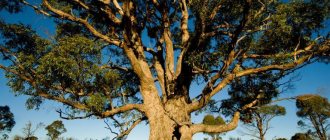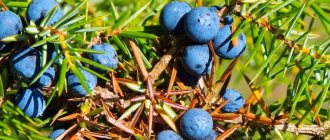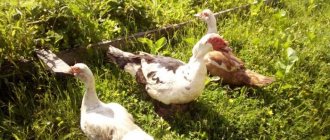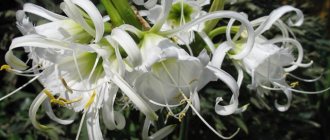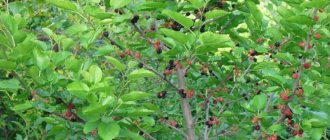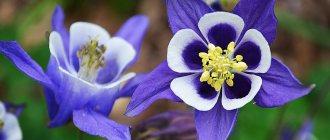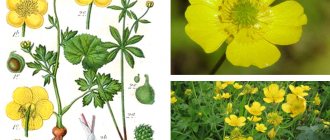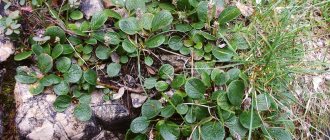Mulberry (Morus), also called mulberry or mulberry tree, is a deciduous tree belonging to the genus of the Mulberry family. According to information taken from various sources, this genus includes 17–24 species. These plants can be found in natural conditions in the temperate and subtropical zones of Africa, North America and Asia. The most popular species include white mulberry; its leaves are eaten by silkworm larvae, and their pupae are used to produce natural silk. Under Ivan the Terrible, people already knew about mulberry in Russia; at that time, a silk-weaving manufactory was created, which produced very delicate fabric for the royal court. In turn, Peter I forbade cutting down mulberries on the territory of the state, as they were considered very valuable. Dense, elastic and heavy mulberry wood is also very valuable; in Central Asia it is used to make various crafts, musical instruments and barrels.
Features of mulberry
While the mulberry is young, it grows extremely quickly, but over time it becomes slower. As a result, the height of such a tree does not exceed 15 meters. Simple leaf blades are often lobed, alternately arranged and jagged along the edge. Spike-shaped inflorescences consist of small flowers that are either female or male (dioecious). However, there are mulberry trees on which both female and male flowers (monoecious) can open at the same time. The length of the fleshy mulberry fruits is from 20 to 30 mm; they are false berries, or rather, drupes of various colors connected into one whole (from dark purple, almost black, to white). This plant is distinguished by its unpretentiousness; it is able to grow and develop normally, even if you do not care for it at all. The mulberry tree begins to bear fruit in the fifth year of life. The average lifespan of such a plant is about two hundred years; today there are specimens that are at least 500 years old.
The most popular among gardeners are two types of mulberries - black and white, but they differ in the color of the bark, not the fruit. The white mulberry has a light-colored bark on its branches (cream, pale yellow or white), while the branches of the black mulberry are covered with darker bark. Today, this plant is as widespread in cultivation as other fruit trees, for example: cherry, plum, apple tree, sweet cherry, etc.
Mulberry. Planting and caring for mulberries
Description of mulberry
Mulberry (mulberry tree, mulberry) is a genus of plants of the Mulberry family, which includes 17 species of deciduous trees, common in the subtropical zones of Eurasia and North America. The tree crop is wind pollinated.
Mulberries grow quickly when young, but slow down over time. On average, it reaches a height of 10–15 m. The leaves of the crop are simple, alternate, jagged along the edges. A tree lives up to 200 years, less often up to 300–500.
Wines, vodka and soft drinks are made from mulberry fruits. The berries are also used as a filling for pies, and jams are made based on them.
The most common varieties: white mulberry and black mulberry, are actively cultivated, including in the south of Russia. White mulberry juice can be used to remove black mulberry juice.
In Central Asia, mulberry wood is used to make musical instruments. It is also used as a construction and ornamental material. In Russia, the harvesting of mulberry wood has been prohibited since 2011.
Mulberry propagates by seeds, grafting, suckers, layering and cuttings.
Planting mulberries in open ground
What time to plant
You can plant mulberries in open soil in the spring in April before sap flow begins, or in the fall in September and October, but you need to do it before the rainy season. Many gardeners recommend planting in the fall, as it is believed that if a tree survives the winter months, it is destined to live for many years.
Try to choose the most suitable place in the garden for this plant. Mulberry prefers well-lit areas with reliable protection from cold winds. Mulberries cannot be planted on swampy, sandy and saline soil, and the groundwater in the area must lie at a depth of at least 150 cm. Plants that bear only male flowers cannot bear fruit on their own, but the sex of the seedling can only be determined after he will be 4 or 5 years old. In this regard, experienced gardeners recommend buying three-year-old seedlings that have produced the first offspring.
Planting mulberries in autumn
The hole for planting should be prepared at least 15 days before the day of planting; its size directly depends on the size of the plant’s root system. It should be taken into account that the roots must be placed freely in the pit. The average size of the pit is 0.5x0.5x0.5 m. If the soil on the site is poor, then the depth of the pit is increased, since compost or rotted manure in the amount of 5–7 kilograms will need to be poured onto its bottom, to which 100 grams of superphosphate. This layer must be sprinkled with soil, as it should not come into contact with the root system of the plant. Half a month after preparing the hole, you need to start planting the mulberries directly. The root system of the seedling must be placed in a pit, after it is straightened, it is dug in, and the stem must be shaken all the time, otherwise there will be many voids in the soil. When the plant is planted, the soil in the tree trunk circle needs to be compacted, then 20 liters of water are poured under it. When the liquid is completely absorbed into the soil, the surface of the tree trunk circle should be covered with a layer of mulch. For a thin and weak seedling, you will need a support, which is driven into the center of the bottom of the pit before planting. When the mulberry tree is planted, it should be tied to this support. If the soil on the site is clayey and heavy, then at the bottom of the hole you must make a drainage layer of broken bricks.
Spring planting
Planting mulberries in open ground in autumn and spring is almost the same. The difference is that for spring planting, the pit is prepared in the autumn, and the necessary nutrient mixture is poured into it. Planting is carried out in early spring, it should be completed in April.
Mulberry transplant
Features of cultivation
Caring for mulberries is the same as caring for other garden crops. Timely watering, fertilizing, pruning, prevention of diseases and pests - this is the main list of work required when growing mulberries.
Silkworm tree
Selecting soil and planting location
It is important to choose the optimal location for mulberry in the garden, since this crop is long-lived. The photophilous and heat-loving mulberry requires a sufficiently lit place, protected from the wind.
The soil must be sufficiently fertile. It is not recommended to plant a tree on swampy and poor sandy soil. The presence of groundwater close to the surface of the earth will also adversely affect the growth of mulberry.
Mulberries with only male flowers will not bear fruit on their own; the gender can only be determined from a four-year-old seedling. Experienced gardeners recommend purchasing seedlings of exactly the same age, on which the first harvest has already ripened.
What time to plant
It is recommended to plant a mulberry tree in open ground in April, before sap flow begins, or in the autumn - before rainy, cold weather (September, October). Gardeners prefer autumn for planting, believing that if the mulberry overwinters, it will live for many years.
Watering and fertilizing
Mulberry trees require watering in the spring and in the first month of summer. Watering is stopped in July. This procedure is necessary if the weather has been dry for a long time. Good watering during dry periods will prepare the mulberries for winter hardiness. If there is a sufficiently large amount of natural precipitation, there is no need to water the tree.
The plant needs feeding in the same period as watering - from spring to July. In the spring they feed with fertilizers containing nitrogen, in the summer - with potassium-phosphorus. For the first feeding, nitroammofoska (50 g of fertilizer per 10 liters of water) is suitable. In summer, complex fertilizers are used, for example, “KemiroyUniversal” (20 g per 1 sq.m.). While digging tree trunk circles, you can add ash (200 g per 1 sq.m.).
When watering mulberries, it is recommended to use liquid fermented manure (1 part to 6 parts water) or bird droppings (1 part to 10 parts water) as top dressing. From mid-summer, feeding is stopped so as not to provoke the growth of new shoots, which will not get stronger by winter and will not tolerate winter frosts well.
Loosening and weeding
The near-trunk soil surface must be periodically weeded and loosened. This enriches the roots with oxygen and prevents the occurrence of diseases and pests. After weeding and loosening, the ground can be mulched with sawdust. Sawdust inhibits the growth of weeds, the soil underneath does not dry out, and a crust does not form on the ground. In this case, one condition must be observed - to update the sawdust annually.
Trimming
Pruning of the mulberry crop must be done during the dormant period - complete or partial. It is better to carry out this procedure early in the spring, before sap flow occurs. At the end of April - early May, rejuvenating pruning is carried out, and at the same time the crown is formed, until the buds open. In autumn, after leaf fall, the tree needs sanitary pruning. The air temperature during this period should not fall below +10 degrees.
In a young mulberry tree, the height of which reaches 150 cm, all branches must be removed. This must be done so that the branches of an adult tree do not fall to the ground. The central stem is left to grow to a height of 5-6 m, while cutting off competing stems. If you don’t want to regularly make formative prunings, you can leave the crown to grow naturally.
You can form a low mulberry tree; caring for it will be simple and convenient.
To do this, you need to cut off the top at a height of 1.5 - 1.7 meters, then form a “skeleton” of the tree, like a dwarf apple tree. Such a mulberry tree should have about 10 skeletal branches left. The plant requires constant support of the created form. As extraneous branches grow, they are regularly trimmed. Do not remove drooping main branches, but support them.
In the autumn, when the tree sheds all its leaves, it needs to be prepared for winter. Sanitary pruning is necessary to remove injured, dried, disease-damaged branches. Very thin stems, as well as crowns growing inward, are also removed. Sanitary pruning can not be done every year, if this is not necessary: the tree has been well preserved throughout the year.
Transfer
- Before planting, dig up the soil, removing all the weeds. When digging, add fertilizers - humus or rotted manure, wood ash and nitroammophoska. It is not recommended to add peat as a fertilizer, as it acidifies the soil substrate, which is undesirable for mulberries. You can apply fertilizer directly to the planting hole.
- After preparing the ground, we dig a planting hole. Its size will depend on the root system of the plant. The roots of the culture are quite voluminous. The average pit size is 70 by 70 cm, the depth is at least 50 cm.
- Place a drainage layer of expanded clay or broken brick at the bottom of the pit. Sprinkle with a thick layer of humus and water.
- Before planting, keep the mulberry root system in water for 10-15 minutes, saturating it with moisture. The seedling is placed in a prepared hole, and all the roots are carefully straightened.
- Sprinkle with soil, carefully shaking the stem so that there are no voids left in the ground. The soil is compacted and watered abundantly.
- When all the water has been absorbed into the ground, the tree trunk surface is mulched with cut grass, humus or sawdust.
- If the seedling is thin, you need to provide support. Place it in the center of the hole before planting the mulberry tree. When the plant is planted, tie it to a support.
- Mulberry is a large plant. Therefore, when landing, you need to take this circumstance into account. The distance in the vicinity of other representatives of the flora must be at least 4 meters.
It is advisable to buy mulberry seedlings in the region where they are grown. Plants brought from the southern regions adapt less well in the middle zone; it is difficult for them to survive the frosty winter.
Productivity
The first berries may appear on a three-year-old mulberry tree. There are few of them, they ripen singly. On a five-year-old tree, the harvest ripens abundantly and regularly. The size of the berries becomes larger, by the age of 10 their length is maximum. The fruits ripen unevenly, quickly becoming overripe. It is important not to miss the moment of picking the berries so that they do not fall off. You can lay a cloth under the crown of the mulberry tree, shake the tree, and collect the ripened fruits. The berries are used for food immediately, as their shelf life is short, or they are processed.
Preparing for winter
The tops of the shoots are more often exposed to freezing. Spring frosts are the most dangerous for the plant, especially during the flowering period; then you don’t have to wait for berries. Therefore, preparatory work for wintering is very important.
The preparation stages are as follows:
- Mulch the soil near the trunk with sawdust, fallen leaves or straw. Cover the top with a layer of mulch with spruce branches; they are needed to retain snow.
- There is no need to wrap the trunk, since the shoots usually freeze slightly.
- At the end of October, trim off the green parts of the shoots that have not yet become woody. They are most vulnerable in cold weather.
- During the period of spring frosts, you can make smoke fires, which will protect young leaves and flowers from freezing.
- It is recommended to cover young trees completely for the winter. The trunk needs to be wrapped and covering material placed over the branches. Secure the covering with boards and other heavy objects so that winter winds do not demolish this structure. Remove the cover after the threat of spring frosts, not earlier than May. It is advisable to spread poison for rodents under such a “blanket” so that they do not damage the trunk and young branches.
Growing mulberries in the garden
You need to care for mulberries grown in the garden in the same way as other crops. It needs to be watered, weeded, pruned, fed, treated against pests and diseases in a timely manner, and the surface of the tree trunk needs to be loosened.
Mulberry processing
To significantly reduce the risk of a tree being damaged by various diseases or pests, it is necessary to regularly carry out preventive treatments, and it is necessary to spray not only the plant itself, but also the surface of the tree trunk circle. Insecticides and fungicides are used for treatments. It is recommended to carry out such spraying in the first days of April on dormant buds, as well as in October, when the growing season ends. A solution of Nitrafen or Bordeaux mixture (3%) will help you cope with various diseases and pests. In the spring, it is recommended to spray the tree with a urea solution (7%), which will destroy all pests and pathogenic microorganisms, and will also become a source of nitrogen for the plant, which it so needs at the beginning of the growing season.
Watering mulberries
To make the mulberry tree more winter-hardy, it must be watered regularly from the beginning of spring until July. This should be done during severe drought. Starting in July, the plant cannot be watered. If there is a large amount of rain in spring, then there is no need to water the mulberries.
Mulberry feeding
From the beginning of spring until July, such a tree needs feeding. In spring, the plant most of all needs nitrogen fertilizers, and in summer - potassium and phosphorus fertilizers.
Mulberry in the Moscow region and Moscow
The Moscow and Moscow region climate is not entirely suitable for growing mulberries. However, they have long since learned to grow such southern crops as apricots, grapes, and mulberries are no longer so rare. This plant, covered with snow, can survive air temperatures dropping to minus 30 degrees. However, if the winter period turns out to have little snow, then the mulberry tree may die even when the temperature drops to minus 7–10 degrees. In this regard, when planting mulberries in the Moscow region, its root collar should not be deeply buried in the soil.
Since the length of daylight hours in the Moscow region does not meet the requirements of mulberries, such a plant, which is grown in the Moscow region, has 2 growing seasons per year - in spring and autumn. This tree has an unusual ability; it can form cork tissue between the mature and unripe parts of the stem. As a result, in the autumn the mulberry tree can shed those parts of the shoot that are not viable, which will allow it to survive the winter well. In this regard, in the autumn in the Moscow region and Moscow, not only the leaf blades of such a crop fly off, but also parts of the stems. This is the only difference in mulberry cultivation compared to warmer regions.
Mulberry in Siberia
This plant can be cultivated in Siberia only if its frost resistance is increased. This is difficult to do, but possible if desired. If a gardener has a very strong desire to grow mulberries in a region with a cold climate, then he should definitely study the articles of experienced gardeners V. Shalamov and G. Kazanin.
Features of growing mulberries
Useful properties and contraindications
Mulberries are a storehouse of vitamins and microelements, which are very important for human health and improving their immunity.
The fruits are widely used for medicinal purposes. They treat diseases of the digestive tract and colds. A decoction of dried fruits is drunk for stress and insomnia, heavy physical and mental stress to restore strength.
Mulberries contain a lot of iron, which is necessary to improve blood composition. They are rich in fiber, which is good for digestion and lowers blood cholesterol levels. Anthocyanins contained in berries help with inflammatory processes, diabetes, and protect against bacterial infections.
Not only the fruits are eaten, but also an infusion of the leaves and decoctions of the bark and roots are prepared. Such drugs are used as a diuretic and antipyretic.
Individual intolerance is a contraindication when consuming tasty fruits. Berries are not considered allergenic. The amount of food consumed should be limited if you have diabetes. You should not eat berries with cold water, so as not to provoke diarrhea.
Mulberry pruning
It is recommended to prune mulberries during partial or complete dormancy. The tree tolerates pruning best in early spring before sap flow begins. As a rule, rejuvenating and formative pruning is recommended to be carried out from the last days of April to the first days of May before the buds open. In the autumn, when the leaf fall ends, sanitary pruning is carried out, and the air temperature outside should not be less than minus 10 degrees.
How to trim mulberries
Different types of mulberries have different pruning habits. For example, weeping mulberry needs thinning pruning, as well as shortening of stems and branches. Since this species recovers in a relatively short time, it is not afraid of even very severe pruning.
The stamped mulberry tree only needs to shape the crown. To do this, on a long stem with no branches at all, you need to form a lush spherical cap or a cascade of branches.
Decorative mulberries are the most difficult to form. It will also be difficult to systematically maintain the original shape of the tree.
Mulberry pruning in spring
While the plant is young, all branches must be cut off from its trunk to a height of 150 centimeters. In this case, the branches of an adult plant will not descend to the surface of the site. The preserved conductor can be grown to 5–6 meters, while cutting off all competing stems. If you don’t want to do formative pruning, then just let the crown grow naturally. You can form a not very tall tree that is easy to care for. To do this, the apical shoot must be cut at a height of 1.35–1.7 m, then the skeleton is formed, which should be similar to a dwarf apple tree. Such a tree should have from 8 to 10 skeletal branches. When the plant is formed, you will need to maintain the created shape by cutting and plucking those stems that are not needed. It is not recommended to prune drooping branches; instead, they should be supported.
Pruning a three-year-old mulberry
Mulberry pruning in autumn
When all the leaves fly off the tree in autumn, you need to start preparing it for wintering. So, at this time it is necessary to carry out mandatory sanitary pruning; for this, all injured, dried out, damaged by frost or disease, excessively thin branches and stems, as well as those that grow inside the crown, should be cut out. As a rule, mulberries do not need annual sanitary pruning.
Caring for mulberries immediately after planting
The first two years of a tree’s life in a new place, it requires regular watering (10 liters of water per day during dry periods) and regular (once a season) fertilizing. In the spring, during the period of bud break, nitroamaphoska is added at the rate of 50 grams per 10 liters of water.
In summer, complex fertilizer is applied at the rate of 20 grams per 1 square meter. In the fall, the ground under the mulberries is dug up and ash is added to it at the rate of 200 grams per square meter. A positive effect can also be expected when adding organic matter: slurry or bird droppings.
Those who have already planted at least one mulberry tree on their plot have the opportunity to see it bloom every year. Unfortunately, this flowering cannot be called violent, and not because there are few flowers, but their appearance is not very pleasing to the eye of the demanding public.
What work needs to be done in the fall to prepare fruit trees for winter
Planting and replanting trees in autumn: recommendations from experienced gardeners
What are the benefits of pomegranate for health and immunity?
The inconspicuous appearance of mulberry flowers is more than compensated by the excellent taste of the berries, which grow on every tree in countless quantities.
Mulberry propagation
Mulberry can be propagated by the generative (seed) method, as well as vegetatively - by grafting, suckers, lignified and green cuttings, and also layering.
How to grow from seeds
The seeds should be removed from the current season's fruits around mid to last days of October, to do this all the pulp must be removed. Then they are immersed for 1–2 hours in a solution of a growth stimulating agent (for example, Zircon or Epin). After this, they are sown in open soil. If you start sowing at the beginning of the spring, the seeds will need to be stratified for 4–8 weeks beforehand. It is possible not to stratify the seeds, but in this case they will need pre-sowing preparation. To do this, in the spring, immediately before sowing, the seeds must be immersed in cold water for 24 hours, then they are taken out and kept for the same amount of time in very warm water (from 50 to 53 degrees).
For the garden bed, choose a well-lit, unshaded place. Then you need to prepare the grooves and spill them with water, having previously dissolved fertilizers intended for fruit and berry crops in it. The seeds of this plant are small, and they need to be sown as rarely as possible. They should be buried 30–50 mm into the soil. The bed should be well watered when the seeds are embedded in the soil, and then its surface should be covered with a layer of mulch. In autumn, the mulch layer is made thicker than in spring, since in winter the seeds may freeze. The emerging seedlings need to be systematically watered, weeded and fed. By the onset of autumn, the grown and strengthened seedlings can be planted, and depending on the variety of mulberry, the distance between the plants should be 3–5 meters. A plant grown from seeds begins to bear fruit after 5 or 6 years. This method of propagation has one significant drawback, namely, a tree grown from seeds inherits only part of the varietal characteristics of the parent plant or does not inherit them at all. In this regard, seedlings grown in this way are most often used as rootstocks for budding.
How to plant mulberries from seeds (part 1)
Mulberry propagation by offspring
If in a very cold winter the mulberry tree is severely damaged by frost, then its developed root shoots can be used to replace the frozen tree. A crown is gradually formed on this offspring. Unnecessary shoots should be removed, and if desired, they can be removed from the soil along with the root system, the stems can be shortened by 1/3 and then used as seedlings. This method is good because the offspring are able to completely preserve the varietal characteristics of the parent plant.
Mulberry propagation by cuttings
If the tree is rooted, then green cuttings can be used to propagate it. But the complexity of this method is that you will need a special installation that can create a fine water suspension in the form of fog in the greenhouse. Cuttings are taken in June–July, at which time the plant experiences active mulberry growth. Cuttings are cut from the stems, which should reach 15 to 20 centimeters in length and have 2 or 3 buds. They are planted in the greenhouse at an angle of 45 degrees. In very loose soil, the lower cut of the cutting should be inserted to a depth of 30 mm. On the cutting you need to leave only a couple of upper leaf plates, which are shortened by ½ part. It is necessary to ensure that the greenhouse has an environment of high humidity. Young shoots and a powerful root system will appear in the plants by autumn, but their planting in open soil should be postponed until the next spring.
Mulberries can also be propagated by semi-lignified cuttings, which are harvested at the same time as green ones. Such cuttings must be rooted in the same way as green ones. The disadvantage of such propagation is that the rooting of semi-lignified cuttings occurs relatively slowly. A tree grown in this way inherits absolutely all varietal characteristics of the parent plant.
Mulberry cuttings
Mulberry grafting
All known methods can be used to graft mulberries. However, experienced gardeners recommend opting for copulation (cut grafting). If simple copulation is used, then the scion and rootstock are spliced, the thickness of which should be the same. On the rootstock and scion between two buds, you need to make oblique cuts, and their length should be equal to the diameter of the plants being joined, multiplied by 4 (for example, if the diameter of the rootstock and scion is 1.2 cm, then the length of the cuts will be 4.8 cm ). Align the sections together and wrap them with any elastic material or budding tape.
Improved tongue copulation is also used. To do this, you need to make cuts on the cuttings and rootstock in the same way as described above, after which they need to be supplemented with tongue cuts. It is necessary to retreat 1/3 of its length from the end of the cut, then a cut is made to the middle of the cut on the scion up, and down on the rootstock. The places of the cuts must be placed next to each other, after which the tongues are wound in such a way that they are aligned very closely. At the very end, the grafting site needs to be wrapped with tape.
Mulberry grafting 1
Description
Mulberry (Morus) is a deciduous tree, often called "mulberry".
Under natural conditions it grows in the subtropics of North America, Africa, and Asia. This genus is not numerous; there are only 10 species in the wild. During the reign of Ivan the Terrible in Russia, people already knew about mulberry. The silk weaving factory produced fine fabric for the royal entourage. Peter I imposed a ban on cutting down the mulberry tree because of its value. In addition to fabric, musical instruments, all kinds of crafts, and utensils were made from dense and elastic wood.
Young mulberries grow quickly, but over time their growth slows down. The height of an adult tree reaches 20 m. The plant has a wide crown, the shape of which is often spherical.
Mulberry lives a long time, the average age is about 150 - 200 years, some species live about 400 years.
The leaf blades look like blades, their edges are jagged, and they are arranged alternately. Inflorescences in the form of a spike, consisting of medium-sized female (monoecious) or male (dioecious) flowers. Some types of mulberries can bear both male and female flowers at the same time.
The fruit is a small polydrupe: diameter 10-40 mm, length 20-30 mm. The color of the fruit, depending on the variety, can be different - from dark purple, even black, to white. Fleshy, sweet and sour fruits are similar to blackberries and raspberries, their shape is spherical, cylindrical or cone-shaped. They have a pleasant aroma.
Productivity is high. From one mulberry tree growing in a favorable climate, you can get up to 200 kilograms of berries per year. The period of fruit ripening also depends on the natural growing area. In the Russian expanses, certain varieties bear fruit in July; the harvest is often harvested in August. The fruiting period depends on the varietal variety; it can last from two weeks to a month or longer.
There is a legend about how the mulberry appeared. In ancient times, one silkworm wove a beautiful girl an unusual dress from light fabric, decorated with lace. The dress turned out not only beautiful, but also had magic. A woman who dressed up in a dress became even more attractive. In addition, she could go a whole day without food. The girls passed the outfit on to each other, and the number of beauties became more and more numerous.
One of the owners of the dress became the king’s bride and did not want to share her wonderful dress with her friends anymore. Angry friends burst into the future queen's palace, grabbed her dress, and tore it to shreds.
At that same moment, before the eyes of the angry women, an amazing transformation of the outfit into a tree took place: a trunk with branches appeared from the hem of the dress, and swollen pinkish buds formed on the branches from small pieces that flew up. Leaves opened from the buds and formed a lush and dense crown.
This tree was called mulberry. The plant is valued not only for its sweet and juicy fruits, but also for producing the finest silk thread, which the silkworm caterpillar “weaves” while feeding on the leaves. Thus, the thread is used to create an elegant dress.
Without the mulberry tree we would not have silk. Progress has stepped far forward, people have learned to produce artificial silk, but it cannot be compared with natural silk. The mulberry not only feeds the silkworm, but has been considered the “tree of life” since ancient times. Its wood was used to make amulets that protected against evil forces. The mulberry tree symbolizes hard work.
Mulberry diseases with photos and descriptions
The mulberry tree is quite resistant to various diseases, but in some cases it can also get sick. Most often it suffers from brown leaf spot (cylindrosporiosis), curly leaf spot, powdery mildew and bacteriosis. The tree can also be damaged by the tinder fungus.
Powdery mildew
Powdery mildew is a fungal disease. The affected plant develops a whitish coating on the surface of the stems and leaf blades. During the dry period, the disease develops most actively, especially if the crown of the plant is thickened. As soon as the first symptoms of the disease are detected, the tree should be sprayed with Bordeaux mixture, Fundazol or a suspension of colloidal sulfur. For preventative purposes, in the autumn you need to rake and destroy all fallen leaves.
Cylindrosporiosis
Brown leaf spot is also a fungal disease. In the affected specimen, red-purple spots with a ring border form on the surface of the leaf blades. As the disease progresses, the leaf tissue inside the spots falls out, and the foliage itself turns yellow and flies off. As soon as the first signs of the disease are noticed, the tree should be treated with Silite solution (1%). In this case, about 3 liters of this solution should be used per plant. Repeated treatment is carried out half a month after the first.
Bacteriosis
Most often, young stems and leaf blades of mulberries are affected by bacteriosis. Irregularly shaped spots appear on their surface, and over time they turn black. As a result of the development of the disease, the leaves curl and fly away, as well as the deformation of the stems, while gum-like clots form on their surface. To combat this disease, use the drug Gamair or Fitoflavin. However, it should be taken into account that a plant suffering from bacteriosis cannot always be cured. In this case, you must try to prevent infection by regularly carrying out preventive treatments.
Small leaf curl
Pests are carriers of a viral disease such as small leaf curl. In a diseased tree, the foliage wrinkles between the veins, and then granular knots form. As the disease progresses, the leaf plates shrink and curl, the stems become very fragile and rough, and an abnormal increase in their number is observed. This disease cannot be cured, which is why preventive measures are so important. To prevent the plant from becoming infected, it is necessary to combat insect vectors, these include all sucking pests, for example: thrips, aphids, mites, etc.
tinder
The tinder fungus settles on a tree and leads to the destruction of its wood. Its spores, getting into wounds and cracks in the bark, parasitize the plant, which leads to the destruction of its trunk. After such a mushroom is discovered, it must be cut out, capturing part of the wood, and destroyed. The resulting wound should be treated with a solution of copper sulfate (5%). Then it must be covered with a mixture, for the preparation of which you need to combine lime, clay and cow dung (1: 1: 2). If there are mechanical damages on the surface of the tree and gum flows out of them, then it is necessary to clean these wounds, then they are disinfected with a solution of copper sulfate (1%), and then they are treated with a solution consisting of Nigrol and wood ash, which must be sifted, taken these components in a ratio of 7:3.
Diseases and pests
Mulberry trees are endowed by nature with extremely high immunity, but they are still threatened with damage from:
- American ifantria is a butterfly that eats up leaves, completely;
- mealybugs.
Pests need to be controlled using special treatments against “Americans”. Both caterpillars and butterflies themselves benefit from organophosphorus insecticides.
It is also necessary to carry out preventive treatment of mulberries in the spring , before the buds open. this simple precaution can either prevent the development of ailments at all, or significantly weaken them.
The mulberry is the best berry tree you can imagine in the garden, and there are practically no limits to the use of its fruits. For example, not so long ago, in the assortment of stores, along with dry figs and the usual dried apricots, dried mulberries , an amazingly tasty and extremely healthy Indian sweet, appeared.
If there is a mulberry tree in the garden, preparing dried berries will not be difficult. Not to mention the widespread use of this plant in folk medicine and home winemaking.
Mulberry pests with photos and descriptions
Pests rarely settle on mulberries. Most often, this plant is harmed by American butterflies, Comstock scale insects, spider mites and mulberry moths.
White American butterfly
The greatest danger to the mulberry tree is the white American butterfly. The caterpillars of this pest are colored brown-green, their surface has orange-yellow stripes on the sides and black warts. These caterpillars are able to gnaw off all the foliage on the mulberry tree. Inspect the tree, trim and destroy any spider nests found. Special catching belts must be installed on the trunk, and the crown of the plant must be sprayed with Chlorophos.
Mulberry moth
Mulberry moth caterpillars also feed on the foliage of this crop. To protect the plant from such pests, it should be treated with Chlorophos in the spring, when the buds begin to swell, because it is at this time that such caterpillars appear.
Spider mites
If spider mites settle on a tree, then you can see the finest cobwebs on it. The pests themselves are very small and cannot be seen with the naked eye. However, such mites pose a great danger to mulberries. Mites pierce the surface of the leaf blades and suck out the juice from them. As a result, the foliage turns brown and flies off. You should also know that this pest is one of the main carriers of viral diseases that cannot be cured. A tick is an arachnid insect, so to exterminate it it is necessary to use acaricidal agents, for example: Actellik, Kleschevit, etc.
Comstock's worm
Another sucking insect is the Comstock mealybug. It settles on the foliage, bark and branches of the mulberry tree. The scale insect also feeds on the sap of the plant, as a result of which it becomes very weak. Because of this pest, tumors and wounds appear on the tree, branches become deformed and dry out, and the foliage turns yellow and flies off. To kill scale insects, the tree must be sprayed with a pesticide.
Variety of varieties
Today, original mulberry varieties grow on Russian territory, created specifically for our country. The first among them - white honey - is white berries up to 3 cm or more in size and has an extraordinary taste. Soft berries wrinkle easily during transportation, which is their only drawback.
Smolenskaya pink variety, growing in central Russia, is frost-resistant. The medium-sized pink fruits have a pleasant taste. A photo of Smolensk pink mulberry allows you to verify this.
Variety Fruit 1 White berries have a pleasant taste and dense consistency. During transportation they do not lose their presentation for a long time.
Among others, it is worth noting such varieties as: Merezhevo, Fruit 4, Black Baroness, Black Prince, Shelly and many others.
Types and varieties of mulberry with description
Mulberry has an extremely confusing classification. According to information taken from various sources, this genus includes 17–200 species. The fact is that there are a large number of natural mulberry hybrids, which some scientists distinguish as independent species. Below we will describe 3 types of mulberries that are most popular among gardeners.
Red mulberry (Morus rubra)
This species is native to North America. This plant is hardy, unpretentious and resistant to cold and drought. The height of such a tree can vary from 10 to 20 meters. The crown has the shape of a tent. The bark is colored brownish-brown. The length of the leaf plates reaches 12 centimeters; they can be round, long-pointed or ovoid, their front surface is rough, and their back surface is felted. The leaf blades on young shoots are deeply lobed. The sweet and sour juicy fruits reach 30 mm in length and are dark red, almost black in color. Outwardly, they are similar to blackberries. The ripening of mulberry fruits is observed in the last days of July. As a rule, representatives of this species are dioecious plants and therefore, in order for them to bear fruit, they need a pair of the opposite sex. Monoecious plants are very rarely found. This species has a decorative form - felt mulberry: the underside of the leaf blades has a dense white pubescence.
Black mulberry (Morus nigra)
This species is native to Afghanistan and Iran. The height of such a tree, which has a spreading crown, can reach no more than 15 meters. Large asymmetrical leaf plates have a broad ovoid shape, their length is about 20 centimeters and their width is about 15 centimeters. Their front surface is rough, and their back surface is felt. The shiny, black fruits are about 30 mm long and have a sweet and sour taste. This species is resistant to drought, but has less winter hardiness compared to white and red mulberries. New forms were derived from the basic form:
- Remontant . This is a very compact dwarf form. It is often cultivated in a container.
- SHELLY No. 150 . This large-fruited form is distinguished by its productivity. The length of juicy and sweet fruits can reach 55 mm. The foliage is also very large, its length can reach up to 50 cm. Such leaf plates are used for decorative purposes.
The following varieties are most popular among gardeners: Royal, Black Prince, Black Pearl, Plodovaya-4 and Nadezhda.
White mulberry (Morus alba)
This species is native to China, where it prefers to grow in deciduous forests. The height of the tree with a lush spherical crown can reach 20 meters. The fissured bark is colored brown. The bark of young branches is colored in various shades from brown-red to green-gray. It is interesting that leaf blades of different sizes and shapes can grow on the same tree. In summer, the color of the foliage is dark green, and in autumn it is yellow-straw. The sweet-tasting fruits can be painted in various colors; their shape is similar to that of raspberries or blackberries. This species is characterized by winter hardiness, unpretentiousness and endurance to urban conditions. There are a large number of decorative forms:
- Weeping . This plant can reach a height of 5 meters. Its drooping branches are very thin.
- Pyramidal . The height of such plants with a narrow pyramidal crown does not exceed 8 meters. The leaf blades are lobed.
- Globular . The lush crown has a spherical shape.
- Spoon-shaped . This multi-stemmed tree reaches a height of 5 meters. The foliage is concave and folded. The berries ripen relatively early.
- Large-leaved. The foliage is about 22 centimeters long.
- Common angustifolia . This bush-like form has small leaf blades that are notched and very rough.
- Dissect-leaved . This plant is elegant. The leaf plates are divided into regular narrow blades. A pair of lateral and apical lobes are too elongated.
- Golden . The color of young shoots and foliage is yellow-golden.
- Tatarskaya . This low-growing tree is characterized by slow growth and high frost resistance. The small leaves are multi-lobed.
If you want to grow mulberries for fruit production, and not for decorating the garden, then you should pay attention to highly productive varieties of white mulberry:
- White honey . This tall plant produces very sweet white berries, reaching a length of 30 mm.
- Dark-skinned woman . The variety is characterized by productivity and winter hardiness. The black berries have a sweet-sour taste and are about 35 mm long.
- White tenderness . The variety has high productivity. Delicate white berries reach 50 mm in length.
- Luganochka . The variety is highly productive. The sweet, cream-colored berries are about 55 mm long.
- Black Baroness . The variety is early ripening and winter-hardy. Sweet fragrant berries reach 35 mm in length.
- Staromoskovskaya . The variety with a spherical crown is winter-hardy. The sweet, almost black fruits are about 30 mm long.
- Ukrainian-6 . This early ripening variety is distinguished by its productivity. Black berries reach 40 millimeters or more in length.
Also popular are varieties such as: Diana, White tenderness, Snow White and Mashenka.
Varieties with the largest fruits: White Tenderness, Shelly No. 150, Black Pearl and Black Prince.
Black mulberry varieties are not suitable for cultivation in the Moscow region. However, some varieties of white mulberry have been successfully cultivated in mid-latitudes for many years, namely: Vladimirskaya, Korolevskaya, Belaya Honey and Staromoskovskaya.
What kind of mulberries do I grow and why exactly them?
Description and features
Usually, in a photo of a mulberry, people try to capture its berries, but the appearance of this tree in bloom is no less beautiful, and fans of the plant believe that it is more aesthetically pleasing than bird cherry and even lilac.
The mulberry tree is a member of the small mulberry family, which contains 16 species of plants. These are deciduous, flowering and fruiting trees, growing both in the subtropics and tropics, and in temperate climates.
In its youth, the tree grows very quickly, however, growth slows down with age. In the absence of pruning and a favorable climate, mulberries grow 10-16 meters in height.
A tree lives for a very long time; the exact time allotted to it by nature is not known. But the mulberry tree is very famous, to which tourists are taken in Israel, telling that under its shade Christ himself rested with his disciples.
Mulberry has very interesting flowering
It is not possible to establish whether this is true or not, but it is quite possible to find out the approximate age of a tree without cutting it down. This is what was done by Israeli and American scientists. The age of this plant definitely exceeded 2000 years.
Everyone's favorite mulberry is a complex fruit, consisting of a drupe and a perianth that has grown into the fleshy part, quite large - the berries usually reach 3-4 cm in length. Mulberry berries are unique in their composition, there are no analogues for them, in these fruits there is a large concentrations available:
- vitamin compounds – groups “B”, “PP”, “C” - in the form most absorbed by the body;
- acids – malic and citric;
- fatty acids – at a level of about 28-30% of the total composition;
- lipids – at the level of 65-69% of the total composition;
- carbohydrates – completely digestible by the human body – glucose, complex sucrose, fructose;
- iron salts;
- essential oils.
Such a rich composition explains the widespread use and benefits of mulberry . In addition to cooking, the berries are used in medicine, and not just in folk recipes, but even in “official status” - the “Code of Pharmaceutical Use of Medicinal Plants in Britain” recommends taking juice extract from mulberries for pulmonary and digestive problems, in particular, as an expectorant and mild laxative.
In addition to the properties of their fruits, mulberry trees have another unique feature. Namely, the area of its distribution. They grow on both hemispheres of the Earth, which allows some botanists to put forward very bold theories about the age of this family of plants.
Mulberries are used for various ailments
Properties of mulberry: benefits and harms
Useful properties of mulberry
Mulberry has healing properties, and this is explained by the vitamins it contains: vitamins A, K, E and C, trace elements selenium, iron, manganese, zinc and copper, macroelements phosphorus, magnesium, calcium, potassium and sodium. The composition of ripe berries includes riboflavin, pantothenic and folic acids, tocopherol, pyridoxine and choline.
In alternative medicine, such fruits are used quite widely. Green fruits help with heartburn and diarrhea, and ripe ones have a laxative effect and are used for constipation. For throat diseases, gargle with fruit juice, which is diluted with boiled water. For bronchitis, acute respiratory infections and bronchial asthma, an infusion of fruits and bark is used.
An infusion of leaves is used as an antipyretic for fever. For hypertension, it is recommended to use a decoction of the bark and roots, which has a diuretic effect. Experts advise a person with myocardial dystrophy and heart disease to eat as many mulberry fruits as possible: 4 times a day, 0.3 kg for 4 weeks.
A decoction of dried fruits should be drunk for insomnia and stress, as it contains many B vitamins, which have a positive effect on carbohydrate and protein metabolism, and also support the activity of the nervous system.
It is also recommended to eat fruits during the recovery period after surgery, as well as during physical overload. The fact is that magnesium, potassium and quercetin contained in fruits have a beneficial effect on hematopoiesis.
Fomedol, which is produced from mulberry leaves in Vietnam, is used for skin diseases and rheumatism.
Powdered bark combined with oil helps to quickly heal cuts, wounds, bruises and ulcers. If you apply the juice of fresh fruits to ringworm several times a day, it will disappear very quickly. However, the most important thing is that mulberry is one of the first places in potassium content. In this regard, it is recommended to use it for hypokalemia (lack of potassium in the body).
The whole truth about mulberries: beneficial properties of mulberries, proper healthy eating
Mulberry fruit uses
Mulberry fruits can be used for direct consumption or for preparing winter supplies, for example:
- juices,
- jelly,
- syrups,
- jams,
- compotes) with other, more acidic fruits.
leave a comment
Click to cancel reply.
Cultivation Secrets
Mulberry does not require special growing conditions; it is enough to follow simple rules.
- The plant will like a warm, draft-free place protected from northern and eastern winds, preferably on the south side of the site.
- Mulberry prefers a well-drained site with loamy and fertile soil. When planting, mineral fertilizer is added to empty sandy soil and drainage is made from broken bricks or crushed stone.
- Mulberry grows poorly in wetlands and low-lying areas with high groundwater levels.
- In hot and dry weather, regular watering is carried out, about 10 liters of water per adult tree. During rainy and cool weather, additional irrigation is not necessary.
- Young specimens must be covered for the winter. The root system is sensitive to low temperatures, so before frost, the tree trunk circle is mulched. With good snow cover, adapted varieties in the middle zone can withstand frost of -30 degrees.
- For better ripening of the wood, pinch the tops of the shoots in the fall and regularly form a crown.
In the middle zone, the white variety reaches a height of 6 m. Annual branches can freeze out during a harsh winter, but the tree quickly grows new shoots.
“Sex change” of a mulberry tree can be triggered by pruning or tearing off leaves.
